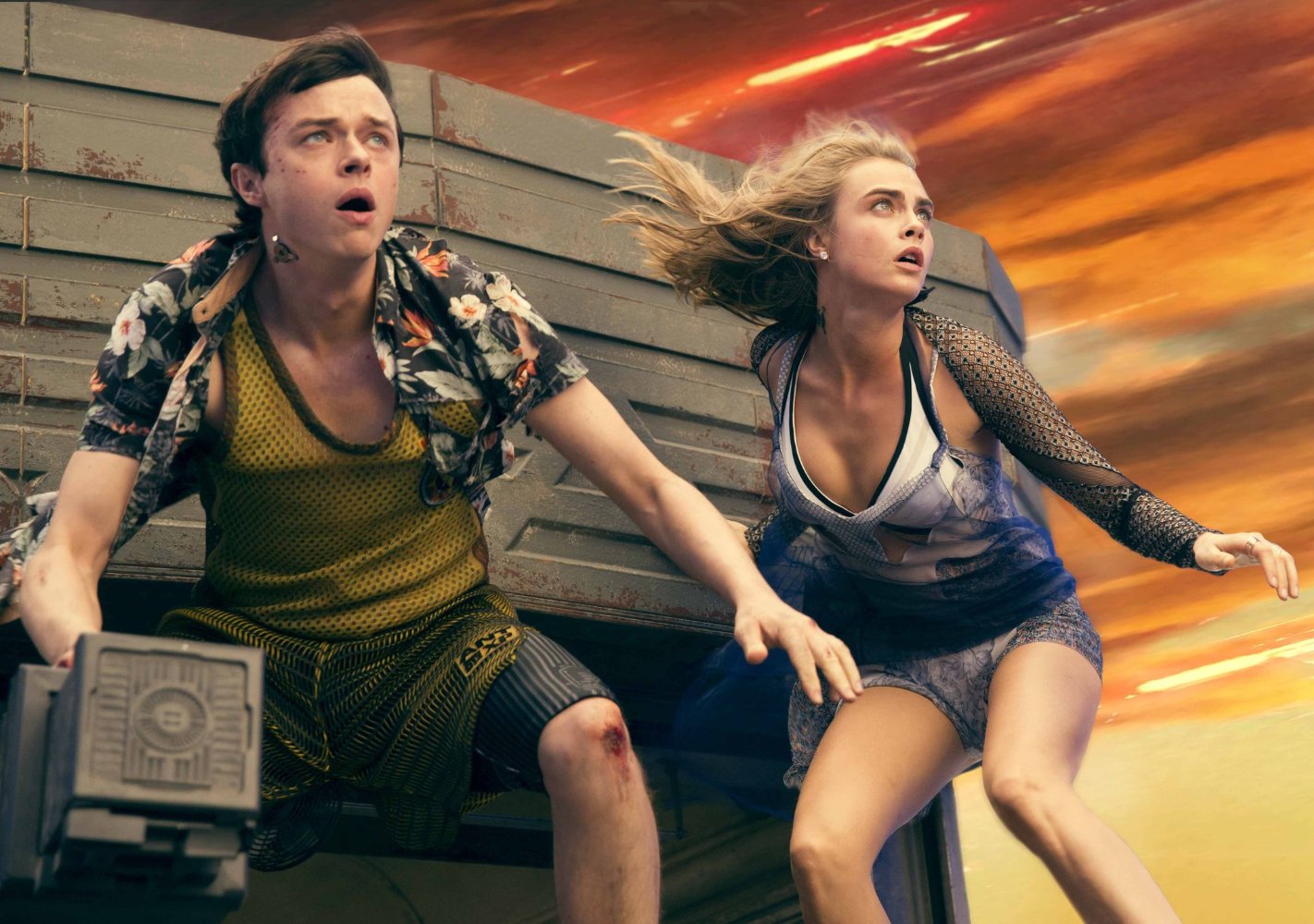
MPAA Rating: PG-13 | Rating: ★★★
Release year: 2017
Genre: Action, Adventure, Sci-Fi Director: Luc Besson
In their very first scene together in Valerian and the City of a Thousand Planets, human government agent Valerian (Dane DeHaan) proposes marriage to his partner, Laureline (Cara Delevingne). It’s a bit of silly dialogue and comic sexual tension, the two agents wrestling around flirtatiously while spouting off witty banter. Delevinge is genuinely alluring and formidable, a strong on-screen presence and clearly enjoying the role and material. DeHaan…isn’t. Perhaps the unconventional casting is intentional, choosing an actor with less of a physical or emotional presence and instead going with someone aloof, awkward, and tired-looking. Much is made throughout the film of Valerian’s sexual conquests and incredible feats of heroism–his character is even given the film’s title, despite the source material including Laureline’s name–but DeHaan’s performance is conspicuously not those things. It’s akin to watching a young, exhausted Leonardo DiCaprio channel a stoic Keanu Reeves while trying to play a Flash Gordon or Han Solo. This film should have been called Laureline and Valerian.
But this film is not really about characterization or plot, though the narrative is fairly simple–Laureline and Valerian are searching for a powerful MacGuffin, a strange “converter” animal which instantly makes replicas of whatever it eats, found on the now-extinct planet Mül, and sought after by various factions and alien species. The value of filmmaker Luc Besson’s multi-million dollar passion project is right there on the screen: the visuals. Valerian, particularly in 3D, is visually stunning. I used the term “smorgasbord” to describe the CGI visuals of Guardians of the Galaxy Vol. 2; this is more like the Sistine Chapel of 3D sci-fi adventures. Every scene is rich with color and detail, the alien worlds and creatures are imaginative and complex, and it all has a lived-in feel to it which goes far beyond many other CGI films. It’s peak world-building. There’s an action sequence at a location called “Big Market” where Valerian must wear special glasses to see the marketplace located in another dimension. Without the glasses, there appears to be only an empty desert; with the glasses, it’s an elaborate alien environment, like an expansive, superior iteration of the Mos Eisley cantina. The scene serves as a metaphor for watching Valerian itself, entering into a new alien dimension with the help of special (3D) glasses. Sometimes directors are described with the term “visionary.” Besson earns the phrase.
Coming back to that marriage proposal, there’s a very strange and confusing blend of conservative gender roles and marital expectations mixed in with progressive sexual ethics. Valerian’s “playlist” of female sexual partners feels overtly sexist, yet by the film’s finale he’s willing to make good on his commitment to marital fidelity. One key supporting character, Bubble (Rihanna), is a shape-shifting pole dancer and prostitute. While it feels strange to praise a somewhat tangential pole-dancing scene, Bubble’s character and motivations feel unique and interesting within this world. She views herself both as an artist and a slave; she is a performer. Coerced by Valerian to help save Laureline from alien, Bubble’s small arc is tragic, eliciting the only moment of genuine pathos in the entire wacky story. Notably in this sequence, Laureline ends up in a white wedding dress of sorts, the special attire as the aliens try to sacrifice her to their ruler. As she’s liberated from the alien captors, she’s also liberated from the dress, a not-too-subtle symbol. Still, it’s hard to say whether this is all in lighthearted fun or if it’s a message the filmmakers want to hammer home. It felt like Besson was attempting to critique sexism while nonetheless creating a fairly sexist film. Perhaps that’s a reflection of the source material? From the Wikipedia entry, the comic series’ themes include:
- Natural simplicity as superior to technological complexity.
- Rejection of machismo, violence and war in favor of femininity and nature.
- Distrust of power and the suppression of individuality.
- The ability of women to manipulate males sexually without being manipulated themselves.
While the third and fourth points are established in the film, the first two seem disregarded, even reversed. Valerian‘s entire spectacle, both in form and content, is a celebration of technology and masculinity, despite its most interesting characters being female. Eight hundred years into the future, and apparently we still haven’t figured much out regarding romantic love, marriage, and gender.
All this to say, Valerian is an imaginative, lavish visual feast. It’s weird and wild, even wonderful. It joins a very small list of films I’ve seen where I was thankful to view it in 3D: Avatar, How to Train Your Dragon, Hugo, and Doctor Strange. Speaking of strange, imagine the following: galactic jellyfish anuses which can show time and memory if you stick your head inside; a triplet of chatty aardvark aliens which reveal knowledge one word at a time; Ethan Hawke as an eye-shadow-sporting character named “Jolly the Pimp;” an alien princess washing her face with multi-colored pearls. If those elements pique your interest, Laureline and the City of a Thousand Planets might be for you.
IMDB Listing: http://www.imdb.com/title/tt2239822/
Leave a Reply